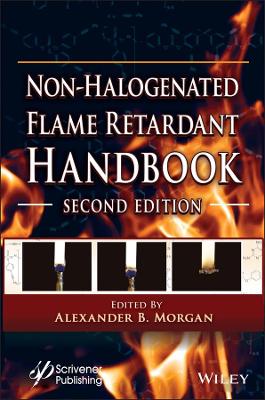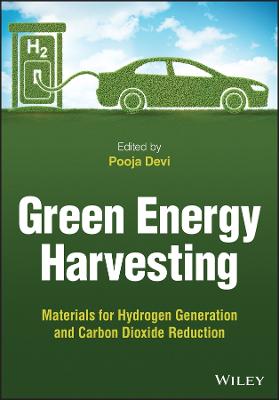Non-halogenated Flame Retardant Handbook
 -15%
portes grátis
-15%
portes grátis
Non-halogenated Flame Retardant Handbook
Morgan, Alexander B.
John Wiley & Sons Inc
12/2021
608
Dura
Inglês
9781119750567
15 a 20 dias
986
Descrição não disponível.
Preface xiii
1 Regulations and Other Developments/Trends/Initiatives Driving Non-Halogenated Flame Retardant Use 1
Alexander B. Morgan
1.1 Regulatory History of Halogenated vs. Non-Halogenated Flame Retardants 1
1.2 Regulations of Fire Safety and Flame Retardant Chemicals 6
1.3 Current Regulations 8
1.3.1 International - United Nations 8
1.3.2 United States (Federal vs. State) 9
1.3.3 Canada 10
1.3.4 European Union 10
1.3.5 Asia 11
1.3.6 China 11
1.3.7 Japan 12
1.3.8 Korea 12
1.3.9 Australia 13
1.4 Fire Safety and Non-Fire Safety Issues Requiring Non-Halogenated Flame Retardants 13
1.5 Regulatory Outlook and Future Market Drivers 16
References 17
2 Phosphorus-Based Flame Retardants 23
Sergei Levchik
2.1 Introduction 24
2.2 Main Classes of Phosphorus-Based Flame Retardants 25
2.3 Red Phosphorus 26
2.4 Ammonium and Amine Phosphates 29
2.5 Metal Hypophosphites, Phosphites and Dialkyl Phosphinates 36
2.6 Aliphatic Phosphates and Phosphonates 40
2.7 Aromatic Phosphates and Phosphonates 48
2.8 Aromatic Phosphinates 58
2.9 Phosphine Oxides 62
2.10 Phosphazenes 64
2.11 Environmental Fate and Exposure to Organophosphorus FRs 65
2.12 Conclusions and Further Trends 67
References 68
3 Mineral Filler Flame Retardants 101
Reiner Sauerwein
3.1 Introduction 101
3.2 Industrial Importance of Mineral Flame Retardants 102
3.2.1 Market Share of Mineral FRs 103
3.2.2 Synthetic Mineral FRs within the Industrial
Chemical Process Chain 104
3.2.3 Natural Mineral FRs 106
3.3 Overview of Mineral Filler FRs 107
3.3.1 Mineral Filler Flame Retardants by Chemistry 107
3.3.2 Classification by Production Process 109
3.3.2.1 Crushing and Grinding 109
3.3.2.2 Air Classification 110
3.3.2.3 Precipitation and Their Synthetic Processes 110
3.3.2.4 Surface Treatment 113
3.3.3 Physical Characterisation of Mineral FRs 114
3.3.3.1 Particle Shape/Morphology/Aspect Ratio 115
3.3.3.2 Particle Size Distribution 116
3.3.3.3 Sieve Residue 117
3.3.3.4 BET Surface Area 118
3.3.3.5 Oil Absorption 118
3.3.3.6 pH-Value/Specific Conductivity 119
3.3.3.7 Bulk Density and Powder Flowability 120
3.3.3.8 Thermal Stability/Loss on Ignition/Endothermic Heat 122
3.3.4 General Impact of Mineral FRs on Polymer Material Properties 123
3.3.4.1 Optical Properties 123
3.3.4.2 Mechanical Properties 123
3.3.4.3 Water Uptake and Chemical Resistance 124
3.3.4.4 Thermal Properties 126
3.3.4.5 Electrical Properties 127
3.3.4.6 Rheological Properties 128
3.4 Working Principle of Hydrated Mineral Flame Retardants 128
3.4.1 Filler Loading, Flammability and Flame Propagation 130
3.4.2 Smoke Suppression 132
3.4.3 Heat Release 134
3.5 Thermoplastic and Elastomeric Applications 136
3.5.1 Compounding Technology 136
3.5.2 Compound Formulation Principals 138
3.5.3 Wire & Cable 140
3.5.4 Other Construction Products 147
3.5.5 Special Applications 150
3.5.6 Engineering Plastics for E&E Applications 152
3.6 Reactive Resins/Thermoset Applications 154
3.6.1 Production Processes for Glass Fiber-Reinforced Polymer Composite 156
3.6.1.1 Paste Production 156
3.6.1.2 Hand Lamination/Hand-Lay-Up 157
3.6.1.3 SMC and BMC 157
3.6.1.4 Pultrusion 158
3.6.1.5 RTM/RIM 158
3.6.2 Formulation Principles 159
3.6.3 Public Transport Applications of GFRP 160
3.6.4 E&E Applications 161
3.6.5 Construction and Industrial Applications 163
3.7 Conclusion, Trends and Challenges 164
References 165
4 Intumescence-Based Flame Retardant 169
Serge Bourbigot
4.1 Introduction 169
4.2 Fundamentals of Intumescence 172
4.3 Intumescence on the Market 179
4.4 Reaction to Fire of Intumescent Materials 180
4.5 Resistance to Fire of Intumescent Materials 204
4.6 Conclusion and Future Trends 224
References 225
5 Nitrogen-Based Flame Retardants 239
Alexander B. Morgan and Martin Klatt
5.1 Introduction 239
5.2 Main Types of Nitrogen-Based Flame Retardants 240
5.3 Ammonia-Based Flame Retardants 241
5.3.1 Ammonium Polyphosphate 242
5.3.2 Other Ammonia Salts 246
5.4 Melamine-Based Flame Retardants 247
5.4.1 Melamine as Flame Retardant 248
5.4.2 Melamine Salts 250
5.4.3 Melamine Cyanurate 251
5.4.4 Melamine Polyphosphate 254
5.4.5 Melamine Condensates and Its Salts 256
5.5 Nitrogen-Based Radical Generators 257
5.6 Phosphazenes, Phospham and Phosphoroxynitride 261
5.7 Cyanuric-Acid Based Flame Retardants 263
5.8 Summary and Conclusion 264
References 265
6 Silicon-Based Flame Retardants 271
Alexander B. Morgan and Mert Kilinc
6.1 Introduction 271
6.2 Basics of Silicon Chemistry 272
6.3 Industrial Applications of Silicones 274
6.4 Silicon-Based Materials as Flame Retardant Materials 277
6.4.1 Inorganic Silicon-Based Flame Retardants 278
6.4.1.1 Silicon Dioxide (SiO2) (Silica) 278
6.4.1.2 Wollastonite 280
6.4.1.3 Magadiite 281
6.4.1.4 Sepiolite 281
6.4.1.5 Kaolin 282
6.4.1.6 Mica 283
6.4.1.7 Talc 283
6.4.1.8 Halloysite 284
6.4.1.9 Layered Silicate Nanocomposites 285
6.4.1.10 Sodium Silicate 289
6.4.1.11 Silsesquioxane 289
6.4.2 Organic Silicone-Based Flame Retardants 290
6.4.2.1 Polyorganosiloxanes 290
6.4.2.2 Silanes 292
6.4.3 Other Silicone-Based Flame Retardants 293
6.4.4 Silicone/Silica Protective Coatings 294
6.5 Mode of Actions of Silicone-Based Flame Retardants and Practical Use Considerations 294
6.5.1 Silicon Dioxide 294
6.5.2 Silicate-Based Minerals 295
6.5.3 Silicones 296
6.6 Future Trends in Silicon-Based Flame Retardants 296
6.7 Summary and Conclusions 298
References 299
7 Boron-Based Flame Retardants in Non-Halogen Based Polymers 309
Kelvin K. Shen
7.1 Introduction 309
7.2 Major Functions of Borates in Flame Retardancy 310
7.3 Major Commercial Boron-Based Flame Retardants and Their Applications 311
7.4 Properties and Applications of Boron-Base Flame Retardants 311
7.4.1 Boric Acid [B2O3?3H2O/B(OH)3], Boric Oxide (B2O3) 311
7.4.2 Alkaline Metal Borate 314
7.4.2.1 Borax Pentahydrate (Na2O?2B2O3?5H2O), Borax Decahydrate (Na2O?2B2O3?10H2O) 314
7.4.2.2 Disodium Octaborate Tetrahydrate (Na2O?4B2O3?4H2O) 315
7.4.3 Alkaline-Earth Metal Borate 317
7.4.3.1 Calcium Borates (xCaO?yB2O3?zH2O) 317
7.4.3.2 Magnesium Borate (xMgO?yB2O3?zH2O) 317
7.4.4 Transition Metal Borates 317
7.4.4.1 Zinc Borates (xZnO?yB2O3?zH2O) 317
7.4.5 Nitrogen-Containing Borates 324
7.4.5.1 Melamine Diborate [(C3H8N6)O?B2O3?2H2O)]/(C3H6N6?2H3BO3 ) 324
7.4.5.2 Ammonium Pentaborate [(NH4)2O?5B2O3?8H2O)] 325
7.4.5.3 Boron Nitride (h-BN) 325
7.4.5.4 Ammonium Borophosphate 327
7.4.6 Phosphorus-Containing Borates 327
7.4.6.1 Boron Phosphate (BPO4) 327
7.4.6.2 Metal Borophosphate 328
7.4.7 Silicon-Containing Borates 328
7.4.7.1 Borosilicate Glass and Frits 328
7.4.8 Carbon-Containing Boron or Borates 329
7.4.8.1 Graphene (Boron-Doped) 329
7.4.8.2 Boric Acid Esters [B(OR)3] 329
7.4.8.3 Boronic Acid [ArB(OH)2] 330
7.4.8.4 Boron Carbide (B4C) 331
7.5 Mode of Actions of Boron-Based Flame Retardants 331
7.6 Conclusions 332
References 333
8 Non-Halogenated Conformal Flame Retardant Coatings 337
Federico Carosio
List of Acronyms 337
8.1 Introduction to Conformal Coatings: The Role of Surface During Combustion 339
8.2 Fabrics 346
8.2.1 Natural Fabrics 347
8.2.2 Synthetic Fabrics and Blends 358
8.2.3 Process Equipment and Related Patents 371
8.3 Porous Materials 373
8.3.1 Open Cell PU Foams 374
8.3.2 Other Porous Substrates 386
8.3.3 Process Equipment and Related Patents 391
8.4 Other Substrates 393
8.5 Future Trends and Needs 396
References 397
9 Multicomponent Flame Retardants 413
Bernhard Schartel
9.1 The Need for Multicomponent Flame Retardants 413
9.2 Concepts 419
9.3 Combination with Fillers 424
9.4 Adjuvants 428
9.5 Synergists 431
9.6 Combinations of Different Flame Retardants 435
9.7 Combinations of Different Flame-Retardant Groups in One Flame Retardant 437
9.8 Conclusion 439
References 439
10 Other Non-Halogenated Flame Retardants and Future Fire Protection Concepts & Needs 475
Alexander B. Morgan, Paul A. Cusack and Charles A. Wilkie
10.1 The Periodic Table of Flame Retardants 475
10.2 Transition Metal Flame Retardants 478
10.2.1 Vapor Phase Transition Metal Flame Retardants 478
10.2.2 Condensed Phase Transition Metal Flame Retardants 479
10.2.2.1 Metal Oxides 480
10.2.2.2 Metal Complexes 481
10.3 Sulfur-Based Flame Retardants 484
10.4 Carbon-Based Flame Retardants 485
10.4.1 Cross-Linking Compounds - Alkynes, Deoxybenzoin, Friedel-Crafts, Nitriles,
Anhydrides 486
10.4.1.1 Alkynes 486
10.4.1.2 Deoxybenzoin 488
10.4.1.3 Friedel-Crafts 488
10.4.1.4 Nitriles 490
10.4.1.5 Anhydrides 490
10.4.2 Organic Carbonates 491
10.4.3 Graft Copolymerization 492
10.4.4 Expandable Graphite 493
10.5 Bio-Based Materials 494
10.6 Tin-Based Flame Retardants 496
10.6.1 Introduction 496
10.6.2 Zinc Stannates 497
10.6.3 Halogen-Free Applications 498
10.6.3.1 Polyolefins 499
10.6.3.2 Styrenics 500
10.6.3.3 Engineering Plastics 500
10.6.3.4 Thermosetting Resins 503
10.6.3.5 Elastomers 503
10.6.3.6 Paints and Coatings 505
10.6.3.7 Textiles 506
10.6.4 Novel Tin Additives 506
10.6.4.1 Coated Fillers 507
10.6.4.2 Tin-Modified Nanoclays 509
10.6.4.3 Mechanism of Action 510
10.6.4.4 Summary 512
10.7 Polymer Nanocomposites 513
10.8 Engineering Non-Hal FR Solutions 513
10.8.1 Barrier Fabrics 514
10.8.2 Coatings 515
10.8.2.1 Inorganic Coatings 515
10.8.2.2 IR Reflective Coatings 517
10.8.2.3 Nanoparticle Coatings 517
10.8.2.4 Conformal/Integrated Coatings 518
10.9 Future Directions 519
10.9.1 Polymeric Flame Retardants and Reactive Flame Retardants 521
10.9.2 End of Life Considerations For Flame Retardants 524
10.9.3 New and Growing Fire Risk Scenarios 528
10.9.4 Experimental Methodology for Flame Retardant Screening 531
References 532
Index 555
1 Regulations and Other Developments/Trends/Initiatives Driving Non-Halogenated Flame Retardant Use 1
Alexander B. Morgan
1.1 Regulatory History of Halogenated vs. Non-Halogenated Flame Retardants 1
1.2 Regulations of Fire Safety and Flame Retardant Chemicals 6
1.3 Current Regulations 8
1.3.1 International - United Nations 8
1.3.2 United States (Federal vs. State) 9
1.3.3 Canada 10
1.3.4 European Union 10
1.3.5 Asia 11
1.3.6 China 11
1.3.7 Japan 12
1.3.8 Korea 12
1.3.9 Australia 13
1.4 Fire Safety and Non-Fire Safety Issues Requiring Non-Halogenated Flame Retardants 13
1.5 Regulatory Outlook and Future Market Drivers 16
References 17
2 Phosphorus-Based Flame Retardants 23
Sergei Levchik
2.1 Introduction 24
2.2 Main Classes of Phosphorus-Based Flame Retardants 25
2.3 Red Phosphorus 26
2.4 Ammonium and Amine Phosphates 29
2.5 Metal Hypophosphites, Phosphites and Dialkyl Phosphinates 36
2.6 Aliphatic Phosphates and Phosphonates 40
2.7 Aromatic Phosphates and Phosphonates 48
2.8 Aromatic Phosphinates 58
2.9 Phosphine Oxides 62
2.10 Phosphazenes 64
2.11 Environmental Fate and Exposure to Organophosphorus FRs 65
2.12 Conclusions and Further Trends 67
References 68
3 Mineral Filler Flame Retardants 101
Reiner Sauerwein
3.1 Introduction 101
3.2 Industrial Importance of Mineral Flame Retardants 102
3.2.1 Market Share of Mineral FRs 103
3.2.2 Synthetic Mineral FRs within the Industrial
Chemical Process Chain 104
3.2.3 Natural Mineral FRs 106
3.3 Overview of Mineral Filler FRs 107
3.3.1 Mineral Filler Flame Retardants by Chemistry 107
3.3.2 Classification by Production Process 109
3.3.2.1 Crushing and Grinding 109
3.3.2.2 Air Classification 110
3.3.2.3 Precipitation and Their Synthetic Processes 110
3.3.2.4 Surface Treatment 113
3.3.3 Physical Characterisation of Mineral FRs 114
3.3.3.1 Particle Shape/Morphology/Aspect Ratio 115
3.3.3.2 Particle Size Distribution 116
3.3.3.3 Sieve Residue 117
3.3.3.4 BET Surface Area 118
3.3.3.5 Oil Absorption 118
3.3.3.6 pH-Value/Specific Conductivity 119
3.3.3.7 Bulk Density and Powder Flowability 120
3.3.3.8 Thermal Stability/Loss on Ignition/Endothermic Heat 122
3.3.4 General Impact of Mineral FRs on Polymer Material Properties 123
3.3.4.1 Optical Properties 123
3.3.4.2 Mechanical Properties 123
3.3.4.3 Water Uptake and Chemical Resistance 124
3.3.4.4 Thermal Properties 126
3.3.4.5 Electrical Properties 127
3.3.4.6 Rheological Properties 128
3.4 Working Principle of Hydrated Mineral Flame Retardants 128
3.4.1 Filler Loading, Flammability and Flame Propagation 130
3.4.2 Smoke Suppression 132
3.4.3 Heat Release 134
3.5 Thermoplastic and Elastomeric Applications 136
3.5.1 Compounding Technology 136
3.5.2 Compound Formulation Principals 138
3.5.3 Wire & Cable 140
3.5.4 Other Construction Products 147
3.5.5 Special Applications 150
3.5.6 Engineering Plastics for E&E Applications 152
3.6 Reactive Resins/Thermoset Applications 154
3.6.1 Production Processes for Glass Fiber-Reinforced Polymer Composite 156
3.6.1.1 Paste Production 156
3.6.1.2 Hand Lamination/Hand-Lay-Up 157
3.6.1.3 SMC and BMC 157
3.6.1.4 Pultrusion 158
3.6.1.5 RTM/RIM 158
3.6.2 Formulation Principles 159
3.6.3 Public Transport Applications of GFRP 160
3.6.4 E&E Applications 161
3.6.5 Construction and Industrial Applications 163
3.7 Conclusion, Trends and Challenges 164
References 165
4 Intumescence-Based Flame Retardant 169
Serge Bourbigot
4.1 Introduction 169
4.2 Fundamentals of Intumescence 172
4.3 Intumescence on the Market 179
4.4 Reaction to Fire of Intumescent Materials 180
4.5 Resistance to Fire of Intumescent Materials 204
4.6 Conclusion and Future Trends 224
References 225
5 Nitrogen-Based Flame Retardants 239
Alexander B. Morgan and Martin Klatt
5.1 Introduction 239
5.2 Main Types of Nitrogen-Based Flame Retardants 240
5.3 Ammonia-Based Flame Retardants 241
5.3.1 Ammonium Polyphosphate 242
5.3.2 Other Ammonia Salts 246
5.4 Melamine-Based Flame Retardants 247
5.4.1 Melamine as Flame Retardant 248
5.4.2 Melamine Salts 250
5.4.3 Melamine Cyanurate 251
5.4.4 Melamine Polyphosphate 254
5.4.5 Melamine Condensates and Its Salts 256
5.5 Nitrogen-Based Radical Generators 257
5.6 Phosphazenes, Phospham and Phosphoroxynitride 261
5.7 Cyanuric-Acid Based Flame Retardants 263
5.8 Summary and Conclusion 264
References 265
6 Silicon-Based Flame Retardants 271
Alexander B. Morgan and Mert Kilinc
6.1 Introduction 271
6.2 Basics of Silicon Chemistry 272
6.3 Industrial Applications of Silicones 274
6.4 Silicon-Based Materials as Flame Retardant Materials 277
6.4.1 Inorganic Silicon-Based Flame Retardants 278
6.4.1.1 Silicon Dioxide (SiO2) (Silica) 278
6.4.1.2 Wollastonite 280
6.4.1.3 Magadiite 281
6.4.1.4 Sepiolite 281
6.4.1.5 Kaolin 282
6.4.1.6 Mica 283
6.4.1.7 Talc 283
6.4.1.8 Halloysite 284
6.4.1.9 Layered Silicate Nanocomposites 285
6.4.1.10 Sodium Silicate 289
6.4.1.11 Silsesquioxane 289
6.4.2 Organic Silicone-Based Flame Retardants 290
6.4.2.1 Polyorganosiloxanes 290
6.4.2.2 Silanes 292
6.4.3 Other Silicone-Based Flame Retardants 293
6.4.4 Silicone/Silica Protective Coatings 294
6.5 Mode of Actions of Silicone-Based Flame Retardants and Practical Use Considerations 294
6.5.1 Silicon Dioxide 294
6.5.2 Silicate-Based Minerals 295
6.5.3 Silicones 296
6.6 Future Trends in Silicon-Based Flame Retardants 296
6.7 Summary and Conclusions 298
References 299
7 Boron-Based Flame Retardants in Non-Halogen Based Polymers 309
Kelvin K. Shen
7.1 Introduction 309
7.2 Major Functions of Borates in Flame Retardancy 310
7.3 Major Commercial Boron-Based Flame Retardants and Their Applications 311
7.4 Properties and Applications of Boron-Base Flame Retardants 311
7.4.1 Boric Acid [B2O3?3H2O/B(OH)3], Boric Oxide (B2O3) 311
7.4.2 Alkaline Metal Borate 314
7.4.2.1 Borax Pentahydrate (Na2O?2B2O3?5H2O), Borax Decahydrate (Na2O?2B2O3?10H2O) 314
7.4.2.2 Disodium Octaborate Tetrahydrate (Na2O?4B2O3?4H2O) 315
7.4.3 Alkaline-Earth Metal Borate 317
7.4.3.1 Calcium Borates (xCaO?yB2O3?zH2O) 317
7.4.3.2 Magnesium Borate (xMgO?yB2O3?zH2O) 317
7.4.4 Transition Metal Borates 317
7.4.4.1 Zinc Borates (xZnO?yB2O3?zH2O) 317
7.4.5 Nitrogen-Containing Borates 324
7.4.5.1 Melamine Diborate [(C3H8N6)O?B2O3?2H2O)]/(C3H6N6?2H3BO3 ) 324
7.4.5.2 Ammonium Pentaborate [(NH4)2O?5B2O3?8H2O)] 325
7.4.5.3 Boron Nitride (h-BN) 325
7.4.5.4 Ammonium Borophosphate 327
7.4.6 Phosphorus-Containing Borates 327
7.4.6.1 Boron Phosphate (BPO4) 327
7.4.6.2 Metal Borophosphate 328
7.4.7 Silicon-Containing Borates 328
7.4.7.1 Borosilicate Glass and Frits 328
7.4.8 Carbon-Containing Boron or Borates 329
7.4.8.1 Graphene (Boron-Doped) 329
7.4.8.2 Boric Acid Esters [B(OR)3] 329
7.4.8.3 Boronic Acid [ArB(OH)2] 330
7.4.8.4 Boron Carbide (B4C) 331
7.5 Mode of Actions of Boron-Based Flame Retardants 331
7.6 Conclusions 332
References 333
8 Non-Halogenated Conformal Flame Retardant Coatings 337
Federico Carosio
List of Acronyms 337
8.1 Introduction to Conformal Coatings: The Role of Surface During Combustion 339
8.2 Fabrics 346
8.2.1 Natural Fabrics 347
8.2.2 Synthetic Fabrics and Blends 358
8.2.3 Process Equipment and Related Patents 371
8.3 Porous Materials 373
8.3.1 Open Cell PU Foams 374
8.3.2 Other Porous Substrates 386
8.3.3 Process Equipment and Related Patents 391
8.4 Other Substrates 393
8.5 Future Trends and Needs 396
References 397
9 Multicomponent Flame Retardants 413
Bernhard Schartel
9.1 The Need for Multicomponent Flame Retardants 413
9.2 Concepts 419
9.3 Combination with Fillers 424
9.4 Adjuvants 428
9.5 Synergists 431
9.6 Combinations of Different Flame Retardants 435
9.7 Combinations of Different Flame-Retardant Groups in One Flame Retardant 437
9.8 Conclusion 439
References 439
10 Other Non-Halogenated Flame Retardants and Future Fire Protection Concepts & Needs 475
Alexander B. Morgan, Paul A. Cusack and Charles A. Wilkie
10.1 The Periodic Table of Flame Retardants 475
10.2 Transition Metal Flame Retardants 478
10.2.1 Vapor Phase Transition Metal Flame Retardants 478
10.2.2 Condensed Phase Transition Metal Flame Retardants 479
10.2.2.1 Metal Oxides 480
10.2.2.2 Metal Complexes 481
10.3 Sulfur-Based Flame Retardants 484
10.4 Carbon-Based Flame Retardants 485
10.4.1 Cross-Linking Compounds - Alkynes, Deoxybenzoin, Friedel-Crafts, Nitriles,
Anhydrides 486
10.4.1.1 Alkynes 486
10.4.1.2 Deoxybenzoin 488
10.4.1.3 Friedel-Crafts 488
10.4.1.4 Nitriles 490
10.4.1.5 Anhydrides 490
10.4.2 Organic Carbonates 491
10.4.3 Graft Copolymerization 492
10.4.4 Expandable Graphite 493
10.5 Bio-Based Materials 494
10.6 Tin-Based Flame Retardants 496
10.6.1 Introduction 496
10.6.2 Zinc Stannates 497
10.6.3 Halogen-Free Applications 498
10.6.3.1 Polyolefins 499
10.6.3.2 Styrenics 500
10.6.3.3 Engineering Plastics 500
10.6.3.4 Thermosetting Resins 503
10.6.3.5 Elastomers 503
10.6.3.6 Paints and Coatings 505
10.6.3.7 Textiles 506
10.6.4 Novel Tin Additives 506
10.6.4.1 Coated Fillers 507
10.6.4.2 Tin-Modified Nanoclays 509
10.6.4.3 Mechanism of Action 510
10.6.4.4 Summary 512
10.7 Polymer Nanocomposites 513
10.8 Engineering Non-Hal FR Solutions 513
10.8.1 Barrier Fabrics 514
10.8.2 Coatings 515
10.8.2.1 Inorganic Coatings 515
10.8.2.2 IR Reflective Coatings 517
10.8.2.3 Nanoparticle Coatings 517
10.8.2.4 Conformal/Integrated Coatings 518
10.9 Future Directions 519
10.9.1 Polymeric Flame Retardants and Reactive Flame Retardants 521
10.9.2 End of Life Considerations For Flame Retardants 524
10.9.3 New and Growing Fire Risk Scenarios 528
10.9.4 Experimental Methodology for Flame Retardant Screening 531
References 532
Index 555
Este título pertence ao(s) assunto(s) indicados(s). Para ver outros títulos clique no assunto desejado.
Flame Retardants; Fire Safety; Non-Halogen; Non-Halogenated Flame Retardants; Material Flammability; Fire Science; Environmentally Friendly Flame Retardants; RoHS; WEEE; Low Smoke; Zero Halogen; LSZH
Preface xiii
1 Regulations and Other Developments/Trends/Initiatives Driving Non-Halogenated Flame Retardant Use 1
Alexander B. Morgan
1.1 Regulatory History of Halogenated vs. Non-Halogenated Flame Retardants 1
1.2 Regulations of Fire Safety and Flame Retardant Chemicals 6
1.3 Current Regulations 8
1.3.1 International - United Nations 8
1.3.2 United States (Federal vs. State) 9
1.3.3 Canada 10
1.3.4 European Union 10
1.3.5 Asia 11
1.3.6 China 11
1.3.7 Japan 12
1.3.8 Korea 12
1.3.9 Australia 13
1.4 Fire Safety and Non-Fire Safety Issues Requiring Non-Halogenated Flame Retardants 13
1.5 Regulatory Outlook and Future Market Drivers 16
References 17
2 Phosphorus-Based Flame Retardants 23
Sergei Levchik
2.1 Introduction 24
2.2 Main Classes of Phosphorus-Based Flame Retardants 25
2.3 Red Phosphorus 26
2.4 Ammonium and Amine Phosphates 29
2.5 Metal Hypophosphites, Phosphites and Dialkyl Phosphinates 36
2.6 Aliphatic Phosphates and Phosphonates 40
2.7 Aromatic Phosphates and Phosphonates 48
2.8 Aromatic Phosphinates 58
2.9 Phosphine Oxides 62
2.10 Phosphazenes 64
2.11 Environmental Fate and Exposure to Organophosphorus FRs 65
2.12 Conclusions and Further Trends 67
References 68
3 Mineral Filler Flame Retardants 101
Reiner Sauerwein
3.1 Introduction 101
3.2 Industrial Importance of Mineral Flame Retardants 102
3.2.1 Market Share of Mineral FRs 103
3.2.2 Synthetic Mineral FRs within the Industrial
Chemical Process Chain 104
3.2.3 Natural Mineral FRs 106
3.3 Overview of Mineral Filler FRs 107
3.3.1 Mineral Filler Flame Retardants by Chemistry 107
3.3.2 Classification by Production Process 109
3.3.2.1 Crushing and Grinding 109
3.3.2.2 Air Classification 110
3.3.2.3 Precipitation and Their Synthetic Processes 110
3.3.2.4 Surface Treatment 113
3.3.3 Physical Characterisation of Mineral FRs 114
3.3.3.1 Particle Shape/Morphology/Aspect Ratio 115
3.3.3.2 Particle Size Distribution 116
3.3.3.3 Sieve Residue 117
3.3.3.4 BET Surface Area 118
3.3.3.5 Oil Absorption 118
3.3.3.6 pH-Value/Specific Conductivity 119
3.3.3.7 Bulk Density and Powder Flowability 120
3.3.3.8 Thermal Stability/Loss on Ignition/Endothermic Heat 122
3.3.4 General Impact of Mineral FRs on Polymer Material Properties 123
3.3.4.1 Optical Properties 123
3.3.4.2 Mechanical Properties 123
3.3.4.3 Water Uptake and Chemical Resistance 124
3.3.4.4 Thermal Properties 126
3.3.4.5 Electrical Properties 127
3.3.4.6 Rheological Properties 128
3.4 Working Principle of Hydrated Mineral Flame Retardants 128
3.4.1 Filler Loading, Flammability and Flame Propagation 130
3.4.2 Smoke Suppression 132
3.4.3 Heat Release 134
3.5 Thermoplastic and Elastomeric Applications 136
3.5.1 Compounding Technology 136
3.5.2 Compound Formulation Principals 138
3.5.3 Wire & Cable 140
3.5.4 Other Construction Products 147
3.5.5 Special Applications 150
3.5.6 Engineering Plastics for E&E Applications 152
3.6 Reactive Resins/Thermoset Applications 154
3.6.1 Production Processes for Glass Fiber-Reinforced Polymer Composite 156
3.6.1.1 Paste Production 156
3.6.1.2 Hand Lamination/Hand-Lay-Up 157
3.6.1.3 SMC and BMC 157
3.6.1.4 Pultrusion 158
3.6.1.5 RTM/RIM 158
3.6.2 Formulation Principles 159
3.6.3 Public Transport Applications of GFRP 160
3.6.4 E&E Applications 161
3.6.5 Construction and Industrial Applications 163
3.7 Conclusion, Trends and Challenges 164
References 165
4 Intumescence-Based Flame Retardant 169
Serge Bourbigot
4.1 Introduction 169
4.2 Fundamentals of Intumescence 172
4.3 Intumescence on the Market 179
4.4 Reaction to Fire of Intumescent Materials 180
4.5 Resistance to Fire of Intumescent Materials 204
4.6 Conclusion and Future Trends 224
References 225
5 Nitrogen-Based Flame Retardants 239
Alexander B. Morgan and Martin Klatt
5.1 Introduction 239
5.2 Main Types of Nitrogen-Based Flame Retardants 240
5.3 Ammonia-Based Flame Retardants 241
5.3.1 Ammonium Polyphosphate 242
5.3.2 Other Ammonia Salts 246
5.4 Melamine-Based Flame Retardants 247
5.4.1 Melamine as Flame Retardant 248
5.4.2 Melamine Salts 250
5.4.3 Melamine Cyanurate 251
5.4.4 Melamine Polyphosphate 254
5.4.5 Melamine Condensates and Its Salts 256
5.5 Nitrogen-Based Radical Generators 257
5.6 Phosphazenes, Phospham and Phosphoroxynitride 261
5.7 Cyanuric-Acid Based Flame Retardants 263
5.8 Summary and Conclusion 264
References 265
6 Silicon-Based Flame Retardants 271
Alexander B. Morgan and Mert Kilinc
6.1 Introduction 271
6.2 Basics of Silicon Chemistry 272
6.3 Industrial Applications of Silicones 274
6.4 Silicon-Based Materials as Flame Retardant Materials 277
6.4.1 Inorganic Silicon-Based Flame Retardants 278
6.4.1.1 Silicon Dioxide (SiO2) (Silica) 278
6.4.1.2 Wollastonite 280
6.4.1.3 Magadiite 281
6.4.1.4 Sepiolite 281
6.4.1.5 Kaolin 282
6.4.1.6 Mica 283
6.4.1.7 Talc 283
6.4.1.8 Halloysite 284
6.4.1.9 Layered Silicate Nanocomposites 285
6.4.1.10 Sodium Silicate 289
6.4.1.11 Silsesquioxane 289
6.4.2 Organic Silicone-Based Flame Retardants 290
6.4.2.1 Polyorganosiloxanes 290
6.4.2.2 Silanes 292
6.4.3 Other Silicone-Based Flame Retardants 293
6.4.4 Silicone/Silica Protective Coatings 294
6.5 Mode of Actions of Silicone-Based Flame Retardants and Practical Use Considerations 294
6.5.1 Silicon Dioxide 294
6.5.2 Silicate-Based Minerals 295
6.5.3 Silicones 296
6.6 Future Trends in Silicon-Based Flame Retardants 296
6.7 Summary and Conclusions 298
References 299
7 Boron-Based Flame Retardants in Non-Halogen Based Polymers 309
Kelvin K. Shen
7.1 Introduction 309
7.2 Major Functions of Borates in Flame Retardancy 310
7.3 Major Commercial Boron-Based Flame Retardants and Their Applications 311
7.4 Properties and Applications of Boron-Base Flame Retardants 311
7.4.1 Boric Acid [B2O3?3H2O/B(OH)3], Boric Oxide (B2O3) 311
7.4.2 Alkaline Metal Borate 314
7.4.2.1 Borax Pentahydrate (Na2O?2B2O3?5H2O), Borax Decahydrate (Na2O?2B2O3?10H2O) 314
7.4.2.2 Disodium Octaborate Tetrahydrate (Na2O?4B2O3?4H2O) 315
7.4.3 Alkaline-Earth Metal Borate 317
7.4.3.1 Calcium Borates (xCaO?yB2O3?zH2O) 317
7.4.3.2 Magnesium Borate (xMgO?yB2O3?zH2O) 317
7.4.4 Transition Metal Borates 317
7.4.4.1 Zinc Borates (xZnO?yB2O3?zH2O) 317
7.4.5 Nitrogen-Containing Borates 324
7.4.5.1 Melamine Diborate [(C3H8N6)O?B2O3?2H2O)]/(C3H6N6?2H3BO3 ) 324
7.4.5.2 Ammonium Pentaborate [(NH4)2O?5B2O3?8H2O)] 325
7.4.5.3 Boron Nitride (h-BN) 325
7.4.5.4 Ammonium Borophosphate 327
7.4.6 Phosphorus-Containing Borates 327
7.4.6.1 Boron Phosphate (BPO4) 327
7.4.6.2 Metal Borophosphate 328
7.4.7 Silicon-Containing Borates 328
7.4.7.1 Borosilicate Glass and Frits 328
7.4.8 Carbon-Containing Boron or Borates 329
7.4.8.1 Graphene (Boron-Doped) 329
7.4.8.2 Boric Acid Esters [B(OR)3] 329
7.4.8.3 Boronic Acid [ArB(OH)2] 330
7.4.8.4 Boron Carbide (B4C) 331
7.5 Mode of Actions of Boron-Based Flame Retardants 331
7.6 Conclusions 332
References 333
8 Non-Halogenated Conformal Flame Retardant Coatings 337
Federico Carosio
List of Acronyms 337
8.1 Introduction to Conformal Coatings: The Role of Surface During Combustion 339
8.2 Fabrics 346
8.2.1 Natural Fabrics 347
8.2.2 Synthetic Fabrics and Blends 358
8.2.3 Process Equipment and Related Patents 371
8.3 Porous Materials 373
8.3.1 Open Cell PU Foams 374
8.3.2 Other Porous Substrates 386
8.3.3 Process Equipment and Related Patents 391
8.4 Other Substrates 393
8.5 Future Trends and Needs 396
References 397
9 Multicomponent Flame Retardants 413
Bernhard Schartel
9.1 The Need for Multicomponent Flame Retardants 413
9.2 Concepts 419
9.3 Combination with Fillers 424
9.4 Adjuvants 428
9.5 Synergists 431
9.6 Combinations of Different Flame Retardants 435
9.7 Combinations of Different Flame-Retardant Groups in One Flame Retardant 437
9.8 Conclusion 439
References 439
10 Other Non-Halogenated Flame Retardants and Future Fire Protection Concepts & Needs 475
Alexander B. Morgan, Paul A. Cusack and Charles A. Wilkie
10.1 The Periodic Table of Flame Retardants 475
10.2 Transition Metal Flame Retardants 478
10.2.1 Vapor Phase Transition Metal Flame Retardants 478
10.2.2 Condensed Phase Transition Metal Flame Retardants 479
10.2.2.1 Metal Oxides 480
10.2.2.2 Metal Complexes 481
10.3 Sulfur-Based Flame Retardants 484
10.4 Carbon-Based Flame Retardants 485
10.4.1 Cross-Linking Compounds - Alkynes, Deoxybenzoin, Friedel-Crafts, Nitriles,
Anhydrides 486
10.4.1.1 Alkynes 486
10.4.1.2 Deoxybenzoin 488
10.4.1.3 Friedel-Crafts 488
10.4.1.4 Nitriles 490
10.4.1.5 Anhydrides 490
10.4.2 Organic Carbonates 491
10.4.3 Graft Copolymerization 492
10.4.4 Expandable Graphite 493
10.5 Bio-Based Materials 494
10.6 Tin-Based Flame Retardants 496
10.6.1 Introduction 496
10.6.2 Zinc Stannates 497
10.6.3 Halogen-Free Applications 498
10.6.3.1 Polyolefins 499
10.6.3.2 Styrenics 500
10.6.3.3 Engineering Plastics 500
10.6.3.4 Thermosetting Resins 503
10.6.3.5 Elastomers 503
10.6.3.6 Paints and Coatings 505
10.6.3.7 Textiles 506
10.6.4 Novel Tin Additives 506
10.6.4.1 Coated Fillers 507
10.6.4.2 Tin-Modified Nanoclays 509
10.6.4.3 Mechanism of Action 510
10.6.4.4 Summary 512
10.7 Polymer Nanocomposites 513
10.8 Engineering Non-Hal FR Solutions 513
10.8.1 Barrier Fabrics 514
10.8.2 Coatings 515
10.8.2.1 Inorganic Coatings 515
10.8.2.2 IR Reflective Coatings 517
10.8.2.3 Nanoparticle Coatings 517
10.8.2.4 Conformal/Integrated Coatings 518
10.9 Future Directions 519
10.9.1 Polymeric Flame Retardants and Reactive Flame Retardants 521
10.9.2 End of Life Considerations For Flame Retardants 524
10.9.3 New and Growing Fire Risk Scenarios 528
10.9.4 Experimental Methodology for Flame Retardant Screening 531
References 532
Index 555
1 Regulations and Other Developments/Trends/Initiatives Driving Non-Halogenated Flame Retardant Use 1
Alexander B. Morgan
1.1 Regulatory History of Halogenated vs. Non-Halogenated Flame Retardants 1
1.2 Regulations of Fire Safety and Flame Retardant Chemicals 6
1.3 Current Regulations 8
1.3.1 International - United Nations 8
1.3.2 United States (Federal vs. State) 9
1.3.3 Canada 10
1.3.4 European Union 10
1.3.5 Asia 11
1.3.6 China 11
1.3.7 Japan 12
1.3.8 Korea 12
1.3.9 Australia 13
1.4 Fire Safety and Non-Fire Safety Issues Requiring Non-Halogenated Flame Retardants 13
1.5 Regulatory Outlook and Future Market Drivers 16
References 17
2 Phosphorus-Based Flame Retardants 23
Sergei Levchik
2.1 Introduction 24
2.2 Main Classes of Phosphorus-Based Flame Retardants 25
2.3 Red Phosphorus 26
2.4 Ammonium and Amine Phosphates 29
2.5 Metal Hypophosphites, Phosphites and Dialkyl Phosphinates 36
2.6 Aliphatic Phosphates and Phosphonates 40
2.7 Aromatic Phosphates and Phosphonates 48
2.8 Aromatic Phosphinates 58
2.9 Phosphine Oxides 62
2.10 Phosphazenes 64
2.11 Environmental Fate and Exposure to Organophosphorus FRs 65
2.12 Conclusions and Further Trends 67
References 68
3 Mineral Filler Flame Retardants 101
Reiner Sauerwein
3.1 Introduction 101
3.2 Industrial Importance of Mineral Flame Retardants 102
3.2.1 Market Share of Mineral FRs 103
3.2.2 Synthetic Mineral FRs within the Industrial
Chemical Process Chain 104
3.2.3 Natural Mineral FRs 106
3.3 Overview of Mineral Filler FRs 107
3.3.1 Mineral Filler Flame Retardants by Chemistry 107
3.3.2 Classification by Production Process 109
3.3.2.1 Crushing and Grinding 109
3.3.2.2 Air Classification 110
3.3.2.3 Precipitation and Their Synthetic Processes 110
3.3.2.4 Surface Treatment 113
3.3.3 Physical Characterisation of Mineral FRs 114
3.3.3.1 Particle Shape/Morphology/Aspect Ratio 115
3.3.3.2 Particle Size Distribution 116
3.3.3.3 Sieve Residue 117
3.3.3.4 BET Surface Area 118
3.3.3.5 Oil Absorption 118
3.3.3.6 pH-Value/Specific Conductivity 119
3.3.3.7 Bulk Density and Powder Flowability 120
3.3.3.8 Thermal Stability/Loss on Ignition/Endothermic Heat 122
3.3.4 General Impact of Mineral FRs on Polymer Material Properties 123
3.3.4.1 Optical Properties 123
3.3.4.2 Mechanical Properties 123
3.3.4.3 Water Uptake and Chemical Resistance 124
3.3.4.4 Thermal Properties 126
3.3.4.5 Electrical Properties 127
3.3.4.6 Rheological Properties 128
3.4 Working Principle of Hydrated Mineral Flame Retardants 128
3.4.1 Filler Loading, Flammability and Flame Propagation 130
3.4.2 Smoke Suppression 132
3.4.3 Heat Release 134
3.5 Thermoplastic and Elastomeric Applications 136
3.5.1 Compounding Technology 136
3.5.2 Compound Formulation Principals 138
3.5.3 Wire & Cable 140
3.5.4 Other Construction Products 147
3.5.5 Special Applications 150
3.5.6 Engineering Plastics for E&E Applications 152
3.6 Reactive Resins/Thermoset Applications 154
3.6.1 Production Processes for Glass Fiber-Reinforced Polymer Composite 156
3.6.1.1 Paste Production 156
3.6.1.2 Hand Lamination/Hand-Lay-Up 157
3.6.1.3 SMC and BMC 157
3.6.1.4 Pultrusion 158
3.6.1.5 RTM/RIM 158
3.6.2 Formulation Principles 159
3.6.3 Public Transport Applications of GFRP 160
3.6.4 E&E Applications 161
3.6.5 Construction and Industrial Applications 163
3.7 Conclusion, Trends and Challenges 164
References 165
4 Intumescence-Based Flame Retardant 169
Serge Bourbigot
4.1 Introduction 169
4.2 Fundamentals of Intumescence 172
4.3 Intumescence on the Market 179
4.4 Reaction to Fire of Intumescent Materials 180
4.5 Resistance to Fire of Intumescent Materials 204
4.6 Conclusion and Future Trends 224
References 225
5 Nitrogen-Based Flame Retardants 239
Alexander B. Morgan and Martin Klatt
5.1 Introduction 239
5.2 Main Types of Nitrogen-Based Flame Retardants 240
5.3 Ammonia-Based Flame Retardants 241
5.3.1 Ammonium Polyphosphate 242
5.3.2 Other Ammonia Salts 246
5.4 Melamine-Based Flame Retardants 247
5.4.1 Melamine as Flame Retardant 248
5.4.2 Melamine Salts 250
5.4.3 Melamine Cyanurate 251
5.4.4 Melamine Polyphosphate 254
5.4.5 Melamine Condensates and Its Salts 256
5.5 Nitrogen-Based Radical Generators 257
5.6 Phosphazenes, Phospham and Phosphoroxynitride 261
5.7 Cyanuric-Acid Based Flame Retardants 263
5.8 Summary and Conclusion 264
References 265
6 Silicon-Based Flame Retardants 271
Alexander B. Morgan and Mert Kilinc
6.1 Introduction 271
6.2 Basics of Silicon Chemistry 272
6.3 Industrial Applications of Silicones 274
6.4 Silicon-Based Materials as Flame Retardant Materials 277
6.4.1 Inorganic Silicon-Based Flame Retardants 278
6.4.1.1 Silicon Dioxide (SiO2) (Silica) 278
6.4.1.2 Wollastonite 280
6.4.1.3 Magadiite 281
6.4.1.4 Sepiolite 281
6.4.1.5 Kaolin 282
6.4.1.6 Mica 283
6.4.1.7 Talc 283
6.4.1.8 Halloysite 284
6.4.1.9 Layered Silicate Nanocomposites 285
6.4.1.10 Sodium Silicate 289
6.4.1.11 Silsesquioxane 289
6.4.2 Organic Silicone-Based Flame Retardants 290
6.4.2.1 Polyorganosiloxanes 290
6.4.2.2 Silanes 292
6.4.3 Other Silicone-Based Flame Retardants 293
6.4.4 Silicone/Silica Protective Coatings 294
6.5 Mode of Actions of Silicone-Based Flame Retardants and Practical Use Considerations 294
6.5.1 Silicon Dioxide 294
6.5.2 Silicate-Based Minerals 295
6.5.3 Silicones 296
6.6 Future Trends in Silicon-Based Flame Retardants 296
6.7 Summary and Conclusions 298
References 299
7 Boron-Based Flame Retardants in Non-Halogen Based Polymers 309
Kelvin K. Shen
7.1 Introduction 309
7.2 Major Functions of Borates in Flame Retardancy 310
7.3 Major Commercial Boron-Based Flame Retardants and Their Applications 311
7.4 Properties and Applications of Boron-Base Flame Retardants 311
7.4.1 Boric Acid [B2O3?3H2O/B(OH)3], Boric Oxide (B2O3) 311
7.4.2 Alkaline Metal Borate 314
7.4.2.1 Borax Pentahydrate (Na2O?2B2O3?5H2O), Borax Decahydrate (Na2O?2B2O3?10H2O) 314
7.4.2.2 Disodium Octaborate Tetrahydrate (Na2O?4B2O3?4H2O) 315
7.4.3 Alkaline-Earth Metal Borate 317
7.4.3.1 Calcium Borates (xCaO?yB2O3?zH2O) 317
7.4.3.2 Magnesium Borate (xMgO?yB2O3?zH2O) 317
7.4.4 Transition Metal Borates 317
7.4.4.1 Zinc Borates (xZnO?yB2O3?zH2O) 317
7.4.5 Nitrogen-Containing Borates 324
7.4.5.1 Melamine Diborate [(C3H8N6)O?B2O3?2H2O)]/(C3H6N6?2H3BO3 ) 324
7.4.5.2 Ammonium Pentaborate [(NH4)2O?5B2O3?8H2O)] 325
7.4.5.3 Boron Nitride (h-BN) 325
7.4.5.4 Ammonium Borophosphate 327
7.4.6 Phosphorus-Containing Borates 327
7.4.6.1 Boron Phosphate (BPO4) 327
7.4.6.2 Metal Borophosphate 328
7.4.7 Silicon-Containing Borates 328
7.4.7.1 Borosilicate Glass and Frits 328
7.4.8 Carbon-Containing Boron or Borates 329
7.4.8.1 Graphene (Boron-Doped) 329
7.4.8.2 Boric Acid Esters [B(OR)3] 329
7.4.8.3 Boronic Acid [ArB(OH)2] 330
7.4.8.4 Boron Carbide (B4C) 331
7.5 Mode of Actions of Boron-Based Flame Retardants 331
7.6 Conclusions 332
References 333
8 Non-Halogenated Conformal Flame Retardant Coatings 337
Federico Carosio
List of Acronyms 337
8.1 Introduction to Conformal Coatings: The Role of Surface During Combustion 339
8.2 Fabrics 346
8.2.1 Natural Fabrics 347
8.2.2 Synthetic Fabrics and Blends 358
8.2.3 Process Equipment and Related Patents 371
8.3 Porous Materials 373
8.3.1 Open Cell PU Foams 374
8.3.2 Other Porous Substrates 386
8.3.3 Process Equipment and Related Patents 391
8.4 Other Substrates 393
8.5 Future Trends and Needs 396
References 397
9 Multicomponent Flame Retardants 413
Bernhard Schartel
9.1 The Need for Multicomponent Flame Retardants 413
9.2 Concepts 419
9.3 Combination with Fillers 424
9.4 Adjuvants 428
9.5 Synergists 431
9.6 Combinations of Different Flame Retardants 435
9.7 Combinations of Different Flame-Retardant Groups in One Flame Retardant 437
9.8 Conclusion 439
References 439
10 Other Non-Halogenated Flame Retardants and Future Fire Protection Concepts & Needs 475
Alexander B. Morgan, Paul A. Cusack and Charles A. Wilkie
10.1 The Periodic Table of Flame Retardants 475
10.2 Transition Metal Flame Retardants 478
10.2.1 Vapor Phase Transition Metal Flame Retardants 478
10.2.2 Condensed Phase Transition Metal Flame Retardants 479
10.2.2.1 Metal Oxides 480
10.2.2.2 Metal Complexes 481
10.3 Sulfur-Based Flame Retardants 484
10.4 Carbon-Based Flame Retardants 485
10.4.1 Cross-Linking Compounds - Alkynes, Deoxybenzoin, Friedel-Crafts, Nitriles,
Anhydrides 486
10.4.1.1 Alkynes 486
10.4.1.2 Deoxybenzoin 488
10.4.1.3 Friedel-Crafts 488
10.4.1.4 Nitriles 490
10.4.1.5 Anhydrides 490
10.4.2 Organic Carbonates 491
10.4.3 Graft Copolymerization 492
10.4.4 Expandable Graphite 493
10.5 Bio-Based Materials 494
10.6 Tin-Based Flame Retardants 496
10.6.1 Introduction 496
10.6.2 Zinc Stannates 497
10.6.3 Halogen-Free Applications 498
10.6.3.1 Polyolefins 499
10.6.3.2 Styrenics 500
10.6.3.3 Engineering Plastics 500
10.6.3.4 Thermosetting Resins 503
10.6.3.5 Elastomers 503
10.6.3.6 Paints and Coatings 505
10.6.3.7 Textiles 506
10.6.4 Novel Tin Additives 506
10.6.4.1 Coated Fillers 507
10.6.4.2 Tin-Modified Nanoclays 509
10.6.4.3 Mechanism of Action 510
10.6.4.4 Summary 512
10.7 Polymer Nanocomposites 513
10.8 Engineering Non-Hal FR Solutions 513
10.8.1 Barrier Fabrics 514
10.8.2 Coatings 515
10.8.2.1 Inorganic Coatings 515
10.8.2.2 IR Reflective Coatings 517
10.8.2.3 Nanoparticle Coatings 517
10.8.2.4 Conformal/Integrated Coatings 518
10.9 Future Directions 519
10.9.1 Polymeric Flame Retardants and Reactive Flame Retardants 521
10.9.2 End of Life Considerations For Flame Retardants 524
10.9.3 New and Growing Fire Risk Scenarios 528
10.9.4 Experimental Methodology for Flame Retardant Screening 531
References 532
Index 555
Este título pertence ao(s) assunto(s) indicados(s). Para ver outros títulos clique no assunto desejado.







